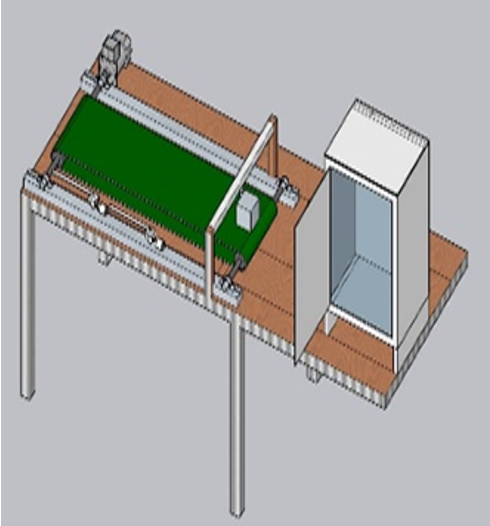Enhancing Electric Motor Control of Electric Motor Installation in Indonesian Vocational Schools Using PLC and VSD Technology with HMI

Downloads
Vocational education plays a crucial role in producing skilled labor that is prepared to meet industry demands. This research aims to develop a learning medium in the form of an Automated Sorting Conveyor System based on PLC, VSD, and HMI technology to enhance the competencies of vocational high school students in the subject of Electric Motor Installation. This study employs a Research and Development approach with the ADDIE development model (Analysis, Design, Development, Implementation, and Evaluation). Feasibility testing was conducted by subject matter experts and media experts, while effectiveness testing was performed through pre-tests and post-tests with 33 eleventh-grade students at State Vocational High School 1 South Kuta. The validation results indicate that the media was rated highly feasible by experts (media: 84.17%, material: 95.17%). The use of Automated Sorting Conveyor System has proven effective in improving student learning outcomes, with an average gain score of 0.333 for theoretical aspects and 0.335 for practical aspects. This study recommends the use of Automated Sorting Conveyor System media in the practical learning of electric motor control in vocational schools, as well as training for teachers to optimize its use.
Downloads
[1] Andriani, D. (2021). A critical review of the labor competitiveness as human capital in Indonesia . International Journal of Research in Business and Social Science (2147- 4478), 10(5), 52–65. https://doi.org/10.20525/ijrbs.v10i5.1303.
[2] Surya B, Menne F, Sabhan H, Suriani S, Abubakar H, Idris M. Economic Growth, Increas-ing Productivity of SMEs, and Open Innovation. Journal of Open Innovation: Technolo-gy, Market, and Complexity. 2021; 7(1):20. https://doi.org/10.3390/joitmc7010020.
[3] Li, L. (2022). Reskilling and upskilling the future-ready workforce for industry 4.0 and beyond. Information Systems Frontiers, 1-16.
[4] Zahidi, S. (2023). Future of jobs report 2023. World Economic Forum, May 2023. https://www3.weforum.org/docs/WEF_Future_of_Jobs_s-23.pdf. Accessed 31 Aug 2024.
[5] Mahmudah, F. N., & Santosa, B. (2021). Vocational School Alignment Based-on Industry Needs. Journal of Vocational Education Studies, 4(1).
[6] Ubaidah, S., Trisnamansyah, S., Insan, H. S., & Harahap, N. (2021). Partnership man-agement between vocational schools with the world of business and industry to improve the quality of graduates who are ready to work. International Journal of Nusantara Islam, 9(1), 58-69.
[7] Mhetraskar, S. S., Namekar, S. A., Holmukhe, R. M., & Tamke, S. M. (2020). Industrial automation using PLC, HMI and its protocols based on real time data for analysis. Int. J. Adv. Res. Eng. Technol.(IJARET), 11(10).
[8] Shaheed, B. N., & Selman, N. H. (2023). Design and implementation of a control system for a steel plate cutting production line using programmable logic controller. International Journal of Electrical & Computer Engineering (2088-8708), 13(4).
[9] Shaheed, B. N., & Selman, N. H. (2023). Developing the control system for the old indus-trial machines using PLC and IIOT. Int J Circuit Comput Networking, 4(2), 13-20.
[10] Mourtzis, D., Angelopoulos, J., & Panopoulos, N. (2023). The future of the human–machine interface (HMI) in society 5.0. Future Internet, 15(5), 162.
[11] Branch, R. M. (2009). Instructional design: The ADDIE approach (Vol. 722). New York: Springer.
[12] Ahmed, M., & Mike, S. (2024). Reducing STEM Attrition Leveraging Digital Tools to En-hance Student Engagement and Success. Journal of Innovation in Educational and Social Research, 2(9), 48-52.
[13] Ghani, M. T. A., Daud, W. A. A. W., & Yusof, M. A. M. (2022). Employing ADDIE instruc-tional design model for educational digital game-based learning. Journal of Algebraic Sta-tistics, 13(3), 5296-5306.
[14] Baidoo-Anu, D., & Ansah, L. O. (2023). Education in the era of generative artificial intelli-gence (AI): Understanding the potential benefits of ChatGPT in promoting teaching and learning. Journal of AI, 7(1), 52-62.
[15] Shadjalilovna, S. M., Malikovna, K. R. N., Mirsharapovna, S. Z., & Kakhramonovich, A. A. (2022). Determination of the Needs of Students by Psychological and Pedagogical Teaching Tools Using Remote Technologies. Texas Journal of Multidisciplinary Studies, 14, 5-8.
[16] Madhakomala, R., Hakim, M. A., & Syifauzzuhrah, N. (2022). Problems of education in Indonesia and alternative solutions. International Journal of Business, Law, and Educa-tion, 3(2), 135-144.
[17] Wibowo, R. A., Nyan, M. L., & Christy, N. N. A. (2022). The challenges for Indonesia to integrate dual vocational education and training system. Journal of technical education and training, 14(2), 79-90.
[18] Upadhyaya, H. (2024). Digital Education And Economic Transformation: Bridging The Gap. MEADOW PUBLICATION.
[19] Aithal, P. S., & Maiya, A. K. (2023). Innovations in Higher Education Industry–Shaping the Future. International Journal of Case Studies in Business, IT, and Education (IJCSBE), 7(4), 283-311.
[20] Yoto, Suyetno, A., Wibawa, A. P., Paryono, & Romadin, A. (2024). Unveiling the Distinc-tive Impact of Vocational Schools Link and Match Collaboration with Industries for Ho-listic Workforce Readiness. Open Education Studies, 6(1), 20240045.
[21] Adewolu Ogwo, A. (2024). Higher Education, skills development and students' prepared-ness for employability: a case study of the University of Lagos, Nigeria (towards a sus-tained practice approach with the triple helix model of innovation) (Doctoral dissertation, UCL (University College London)).
[22] Arsyad, M., Mujahiddin, M., & Syakhrani, A. W. (2024). The Efficiency Of Using Visual Learning Media In Improving The Understanding Of Science Concepts In Elementary School Students. Indonesian Journal of Education (INJOE), 4(3), 775-787.
[23] Febrina, V., & Setiawan, D. (2024). Analysis of the Use of Learning Media on the Learn-ing Interest of Learning Science Students and Environmental Themes. Jurnal Penelitian Pendidikan IPA, 10(8), 5702-5709.
[24] Khoiri, N. (2021). Efektivitas Model Pembelajaran Inkuiri Terhadap Hasil Belajar: The Effectiveness of the Inquiry Learning Model on Learning Outcomes. Jurnal Inovasi Pem-belajaran di Sekolah, 2(1), 127-133.
[25] Minarta, S. M., & Pamungkas, H. P. (2022). Efektivitas media wordwall untuk mening-katkan hasil belajar ekonomi siswa man 1 lamongan. OIKOS: Jurnal Kajian Pendidikan Ekonomi dan Ilmu Ekonomi, 6(2), 189-199.
[26] Khasanah, I. M. (2023). Efektivitas pendekatan culturally responsive teaching (crt) untuk meningkatkan hasil belajar siswa kelas II sekolah dasar. ALIFBATA: Journal of Basic Education, 3(2), 7-14.
[27] Kusumawati, E. R. (2022). Efektivitas media game berbasis scratch pada pembelajaran IPA sekolah dasar. Jurnal Basicedu, 6(2), 1500-1507.
[28] Nurunnabi, A. S. M., Rahim, R., Alo, D., Mamun, A. A., Kaiser, A. M., Mohammad, T., & Sultana, F. (2022). Experiential learning in clinical education guided by the Kolb’s experi-ential learning theory. Int J Hum Health Sci (IJHHS), 6(2), 155.
[29] Matriano, E. A. (2020). Ensuring Student-Centered, Constructivist and Project-Based Experiential Learning Applying the Exploration, Research, Interaction and Creation (ER-IC) Learning Model. International Online Journal of Education and Teaching, 7(1), 214-227.
[30] Permana, R. S. G., Hartiwi, J., & Anti, S. L. (2024). Efektivitas Model Pembelajaran Ino-vatif Project-Based Learning dalam Meningkatkan Hasil Belajar Siswa. Quantum Edukatif: Jurnal Pendidikan Multidisiplin, 1(1), 7-12.
[31] Rini, F., Mary, T., Pratama, A., Devegi, M., Untari, R. T., & Pernanda, A. Y. (2024). Pelati-han Pembuatan Media Pembelajaran Interaktif Menggunakan Assemblr Edu (AR) Da-lam Mendukung Kegiatan Pembelajaran Bagi Guru SMK. Gudang Jurnal Pengabdian Masyarakat, 2(1), 36-40.
[32] Ghosh, L., & Ravichandran, R. (2024). Emerging Technologies in Vocational Education and Training. Journal of Digital Learning and Education, 4(1), 41-49.
[33] Dahalan, F., Alias, N., & Shaharom, M. S. N. (2024). Gamification and game based learn-ing for vocational education and training: A systematic literature review. Education and Information Technologies, 29(2), 1279-1317.
[34] Zhou, C., Li, H., & Bian, Y. (2020). Identifying the optimal 3d display technology for hands-on virtual experiential learning: a comparison study. IEEE access, 8, 73791-73803.
[35] Ravichandran, R. R., & Mahapatra, J. (2023). Virtual reality in vocational education and training: challenges and possibilities. Journal of Digital Learning and Education, 3(1), 25-31.
[36] Poo, M. C. P., Lau, Y. Y., & Chen, Q. (2023). Are Virtual Laboratories and Remote Labor-atories Enhancing the Quality of Sustainability Education?. Education Sciences, 13(11), 1110.
[37] Shaheed, B. N., & Selman, N. H. (2023). Design and implementation of a control system for a steel plate cutting production line using programmable logic controller. International Journal of Electrical & Computer Engineering (2088-8708), 13(4).
[38] Mourtzis, D., Angelopoulos, J., & Panopoulos, N. (2023). The future of the human–machine interface (HMI) in society 5.0. Future Internet, 15(5), 162.
[39] Ausubel, D. P. (1968). Educational psychology: A cognitive view. New York, NY: Holt, Rinehart & Winston.
Copyright (c) 2025 Jurnal Edukasi Elektro

This work is licensed under a Creative Commons Attribution-ShareAlike 4.0 International License.
The Authors submitting a manuscript do so on the understanding that if accepted for publication, copyright publishing of the article shall be assigned to Journal.



















